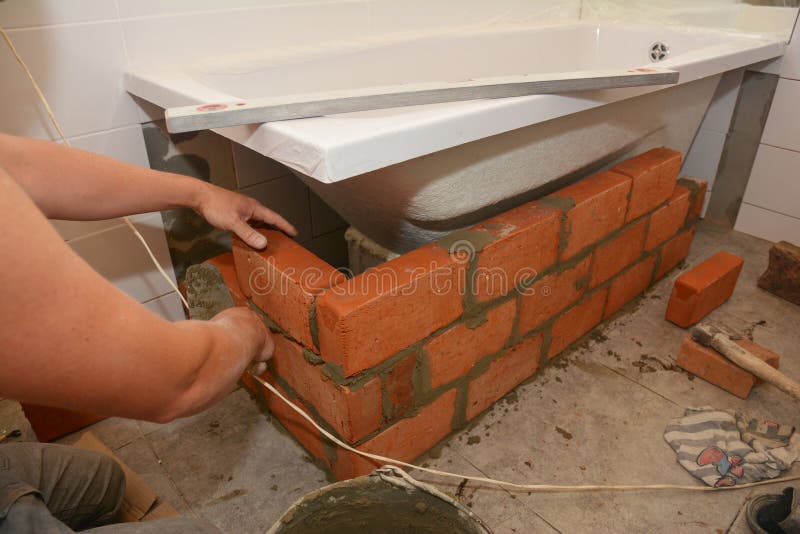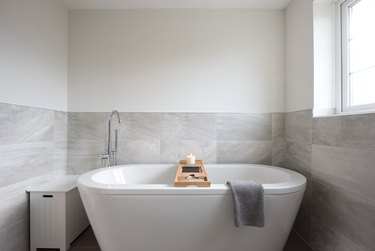Understanding Plumbing Basics is Vital for Installing a Bathtub
Understanding Plumbing Basics is Vital for Installing a Bathtub
Blog Article
They are making a number of great observations related to A Step-by-Step Guide to Installing a Bathtub overall in the article further down.

Mounting a bath tub isn't precisely rocket science, but it does call for strong plumbing, carpentry, and occasionally, tiling abilities. Replacing an old bath tub with a new one is also a moderately hard job. If the old tub is easily available, the task can move easily; if you need to open a wall surface to remove the old bathtub and also place the new bath tub, the job is a lot harder. In either instance, the task is within a home handyman's skills, although you will need a helper to leave the old tub as well as embeded in the brand-new one. Make sure you have certified on your own for the work and also fit trying it. Instead of working with a specialist to take over a halfway-completed job, it is far better to take into consideration employing one prior to you start. Opportunities are you might require an expert plumber to make tube links.
This short article will certainly aid you set up a brand-new bathtub in your washroom if you have actually already acquired a new tub and do not need to alter the plan of your previous supply of water pipes.
Your tools as well as material list need to comprise the following:
Planning for the Installation
Firstly, the sustaining framework supplied with the bath needs to be fitted (if required) according to the manufacturer's instructions. Next off, fit the taps or mixer to the bath tub. When fitting the faucet block, it is necessary to see to it that if the faucet features a plastic washer, it is fitted in between the bath as well as the faucets. On a plastic bathroom, it is additionally practical to fit a supporting plate under the taps device to avoid pressure on the bathtub.
Fit the versatile faucet ports to the bottom of the two faucets utilizing 2 nuts and also olives (often supplied with the bathtub). Fit the plug-hole electrical outlet by smearing mastic filler round the sink electrical outlet hole, and afterwards pass the electrical outlet with the hole in the bathroom. Utilize the nut supplied by the manufacturer to fit the plug-hole. Take a look at the plug-hole electrical outlet for an inlet on the side for the overflow pipe.
Next, fit completion of the versatile overflow pipeline to the overflow outlet. After that, screw the pipe to the overflow face which should be fitted inside the bathroom. Make certain you utilize all of the provided washing machines.
Connect the catch to the bottom of the waste electrical outlet on the bath tub by winding the string of the waste electrical outlet with silicone mastic or PTFE tape, as well as screw on the catch to the outlet. Link all-time low of the overflow tube in a similar manner.The bathroom ought to now prepare to be fitted in its final setting.
Removing Old Touches
If you need to change old taps with new ones as a part of your setup, after that the first thing you ought to do is detach the water supply. After doing so, turn on the faucets to drain any kind of water staying in the system. The process of eliminating the existing faucets can be quite bothersome due to the restricted gain access to that is often the case.
Use a container wrench (crowsfoot spanner) or a tap device to reverse the nut that connects the supply pipes to the faucets. Have a cloth prepared for the remaining water that will come from the pipelines. Once the supply pipes have been removed, utilize the exact same device to loosen the nut that holds the faucets onto the bath/basin. You will certainly need to quit the solitary faucets from turning throughout this process. Once the faucets have been eliminated, the holes in the bath/basin will certainly need to be cleansed of any type of old sealing substance.
Prior to carrying on to fit the brand-new taps, contrast the pipeline links on the old taps to the brand-new taps. If the old faucets are longer than the new faucets, after that a shank adapter is needed for the new taps to fit.
Setting up the Bathtub
Utilizing both wood boards under its feet, position the bath tub in the needed position. The wooden boards are handy in equally spreading the weight of the tub over the area of the boards as opposed to focusing all the weight onto four little points.
The next goal is to ensure that the tub is leveled all round. This can be attained by examining the spirit level and also readjusting the feet on the bath tub until the level checks out level.
To install faucets, fit all-time low of the furthest flexible faucet adapter to the ideal supply pipeline by making a compression sign up with; then do the exact same for the various other tap.
Switch on the water system and examine all joints and brand-new pipework for leakages as well as tighten them if essential. Fill up the tub as well as likewise examine the overflow outlet as well as the normal electrical outlet for leaks.
Finally, take care of the bathroom paneling as explained in the maker's user's manual. Tiling and securing around the bath tub must wait until the bathtub has been utilized a minimum of once as this will certainly resolve it into its final placement.
Fitting New Taps
If the tails of the brand-new faucets are plastic, then you will certainly require a plastic port to avoid damages to the string. One end of the port fits on the plastic tail of the faucet and the various other end supplies a connection to the existent supply pipes.
If you need to fit a monobloc, then you will require lowering couplers, which attaches the 10mm pipe of the monobloc to the conventional 15mm supply pipe.
Next off, place the tap in the mounting hole in the bath/basin making sure that the washing machines are in area in between the faucet as well as the sink. Secure the faucet in position with the manufacturer given backnut. Once the faucet is safely in place, the supply pipelines can be attached to the tails of the faucets. The taps can either be connected by using corrugated copper piping or with regular tap adapters. The previous type needs to be linked to the faucet ends initially, tightening only by hand. The supply pipelines can later on be connected to the other end. Tighten up both ends with a spanner after both ends have actually been connected.
Tiling Around the Bathtub
In the area where the bathroom meets the ceramic tile, it is necessary to seal the joins with a silicone rubber caulking. This is important as the fitting can relocate sufficient to split a stiff seal, creating the water to permeate the wall surface in between the bath as well as the tiling, bring about difficulties with moisture and also feasible leakages to the ceiling listed below.
You can choose from a variety of coloured sealants to blend in your fixtures and installations. They are offered in tubes as well as cartridges, as well as are capable of sealing gaps up to a width of 3mm (1/8 inch). If you have a bigger void to fill, you can fill it with spins of drenched paper or soft rope. Keep in mind to always load the bath tub with water prior to securing, to enable the movement experienced when the tub remains in use. The sealant can crack rather early if you do not take into account this activity before securing.
Additionally, ceramic coving or quadrant floor tiles can be used to border the bathroom or shower tray. Plastic strips of coving, which are easy to use as well as reduce to dimension, are additionally quickly readily available on the market. It is a good idea to fit the ceramic tiles making use of waterproof or waterproof glue and also cement.
Bathtub Installation
How Important Is A Bathtub To Your Home?
High-quality baths, showers, and other bathroom updates are necessary when considering a smart investment in your home. It’s a room that you go to every day and one that is constantly being used by guests.The bathroom is one of the top trafficked rooms in a home and also one of the most valuable in terms of home resale.
Install Piping Before Tub
You will be using your existing drain and waste vent system, but pipes required include the hot and cold water supply lines and a pipe leading to a shower head. A mixing valve and shower head are also needed. Air chambers may be required.
Position the Tub
Lower the tub into place so that the continuous flange fits against the wall studs and rests on 1’x4' or 2’x4' supports. Anchor the tub to the enclosure with nails or screws inserted through the flanges into the studs.
NOTE: Remember, bathtubs and shower stalls may require support framing. A bathtub filled with water is extremely heavy, so check building codes and framing support before installing the tub.
Assemble Drain Connections
Assemble the bathtub drain connections by connecting the tub overflow with the tub drain above the trap, not beyond it. The trap will have a compression fitting that screws over the arm of the overflow assembly.
Place a Pipe For the Shower Head
First, locate a brass female threaded winged fitting and attach it to a framing support via a screw or a nail. Then run a pipe up the wall for the shower head. Sweat or solder the other side of the brass fitting to the top of the pipe.
Attaching Hot and Cold Water Lines
Attach your water lines for both hot and cold by sweating these directly into the hot and cold ports of the mixing valve. The mixing valve will be how water enters the tub’s system, not by the pipes themselves.
Install the Spout
Extend a piece of 1/2 inch pipe, or whichever length is specified in the manufacturer’s instructions, for the tub spout. Sweat on a male threaded fitting at the end of the pipe or use a brass nipple of the proper length and a 1/2 inch cap.
NOTE: At this point you should have your rough-in plumbing work inspected before proceeding further.
Check For Leaks
Restore the water pressure and check the drain connection and the supply pipes for any sign of leaking.
estore the Bathroom Wall
Replace the wall with moisture-resistant drywall as a base for your wall covering. Seal the joints between the wall and your new tub with silicone caulk as protection against water seepage.
https://www.berkeys.com/2016/12/02/bathtub-installation-dallas/

As an enthusiastic reader on How to Install a Bathtub, I figured sharing that portion was a smart idea. Feel free to take the opportunity to promote this write-up if you liked it. I appreciate reading our article about How to Install a Bathtub: Install an Acrylic Tub and Tub Surround.
Book My Estimate Report this page